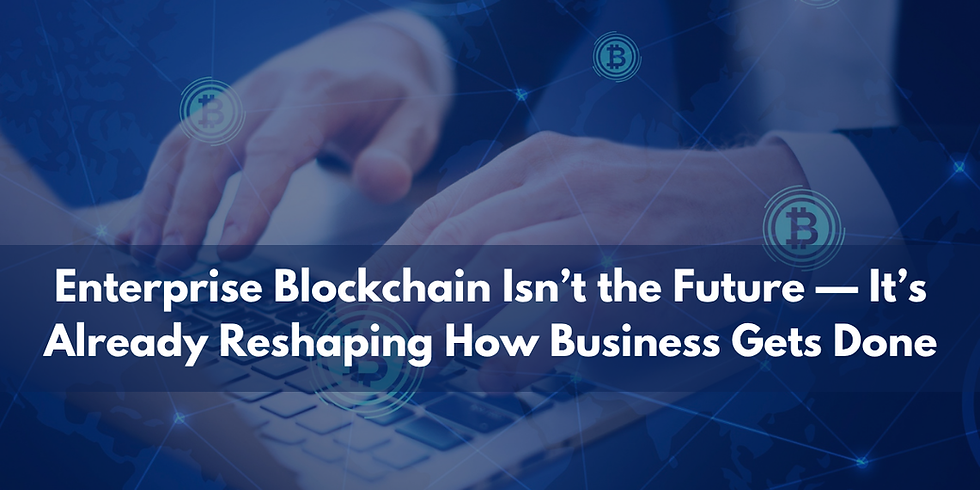Enterprise Blockchain Isn’t the Future — It’s Already Reshaping How Business Gets Done
- Quixom

- Jul 22
- 5 min read

Introduction: Enterprise Blockchain Has Moved Past the Buzz
Just a few years ago, enterprise blockchain felt like another buzzword — full of promise but short on clarity. It was talked about in the same breath as cryptocurrency, smart contracts, and decentralization, but for many business leaders, it raised more questions than answers. Is it secure? Scalable? Worth the investment?
Fast forward to 2025, and the conversation has shifted entirely. Blockchain is no longer an experimental idea sitting in the innovation lab — it's becoming part of the enterprise backbone. Leading organizations are using blockchain to create trust across supply chains, streamline compliance, protect data integrity, and more. And they’re not doing it because it’s trendy — they’re doing it because it works.
This shift didn't happen overnight. It came from years of evolution — both in the technology and in how enterprises think about trust, transparency, and interoperability in the digital age. What we’re seeing now is a maturing space, where enterprise blockchain isn’t just possible — it’s practical, and in many cases, necessary.
The future isn't waiting for blockchain anymore. It’s already being built on it.
What’s Changed — Why Enterprises Are Finally Taking Blockchain Seriously
There was a time when the biggest barrier to blockchain adoption was uncertainty — not just about the tech, but about whether it could solve real business problems at scale. Fast forward to today, and the conversation around blockchain for enterprises has matured dramatically.
So, what changed?
First, the technology itself has evolved. Today’s enterprise blockchain platforms are faster, more secure, and far more interoperable than early versions. They integrate better with existing infrastructure and don’t require companies to overhaul their entire stack just to experiment. Blockchain has also moved away from “one-size-fits-all.” Enterprises now have the flexibility to choose between private, public, or hybrid models depending on their needs.
Second, the business drivers have become clearer. Companies aren’t pursuing blockchain for novelty anymore — they’re using it to reduce fraud, increase transparency, and automate trust in areas like supply chain traceability, digital identity, and cross-border payments.
And finally, there’s mindset. Enterprises have shifted from thinking “Is blockchain right for us?” to “Where does blockchain fit into our strategy?” It’s no longer a question of if — it’s a question of when and how.
For the first time, blockchain is being seen not as a disruptor, but as an enabler of stability, trust, and competitive edge.
Why Blockchain Is Becoming a Boardroom Conversation in 2025
In 2025, blockchain is no longer just a topic for IT departments or innovation labs — it’s showing up in board meetings, C-suite offsites, and strategic planning sessions. The reason? It’s solving business problems that sit squarely in executive territory: trust, risk, efficiency, and transparency.
For years, blockchain was seen as a “tech experiment.” But today, forward-looking executives are realizing its potential as an enabler of long-term enterprise value. From CFOs looking to improve audit trails and reduce fraud, to Chief Supply Chain Officers demanding real-time traceability — the interest is no longer technical, it’s strategic.
Even regulators and compliance teams are driving the conversation. With increasing pressure around ESG, digital provenance, and data integrity, enterprise blockchain is being viewed as a safeguard, not a gamble.
More importantly, boardrooms are asking a different kind of question: not “Should we invest in blockchain?” but “What’s the cost of ignoring it?”
This shift isn’t driven by hype — it’s driven by measurable outcomes and competitive pressure. Companies that adopt too late may find themselves locked out of trusted ecosystems, supply chain networks, or digital finance frameworks already being built on blockchain foundations.
In other words, blockchain has graduated. And leadership is paying attention.
From Vision to Implementation — How Enterprises Are Getting Blockchain Done
It’s one thing to believe in blockchain’s potential — it’s another to actually implement it. For enterprises, the journey from vision to deployment isn’t always straightforward. That’s where experience, planning, and the right blockchain development services come in.
Enterprises aren’t just looking for code — they need partners who understand both business context and tech architecture. Implementation today often means integrating blockchain into legacy systems, ensuring compliance with data regulations, and aligning with business goals that extend well beyond the IT department.
The first question smart enterprises ask is: What problem are we trying to solve? From there, decisions around platform (Hyperledger, Ethereum, private vs. public), governance, security, and scalability follow — ideally led by a cross-functional team, not just tech leads.
Good blockchain development services don’t just write smart contracts — they help enterprises build frameworks for long-term use, future integrations, and performance. That often includes everything from API orchestration to user experience to ensuring cross-chain interoperability.
In 2025, successful implementation is less about building something new, and more about building something that works — reliably, securely, and at scale. It’s not about “doing blockchain.” It’s about building trust into the fabric of business systems.
Choosing the Right Blockchain Approach for Your Enterprise
No two enterprises are the same — and neither are their blockchain needs. Choosing the right approach isn’t just about picking the best tech, it’s about aligning with your business model, risk appetite, and digital strategy.
Start with the basics: Why are you considering blockchain? Is it for improving supply chain visibility? Enhancing data integrity? Automating compliance? The “why” will determine everything from architecture to governance.
Next comes the build vs. buy decision. Some enterprises opt for custom-built solutions, leveraging enterprise blockchain solutions tailored to their exact needs. Others integrate existing platforms that offer proven reliability and faster time to value. The right path depends on your in-house capabilities, timeframes, and how central blockchain is to your competitive advantage.
Then there’s the question of network design. Do you need a private permissioned blockchain with tight control and clear governance? Or does a public or hybrid model better serve your goals for transparency and decentralization?
The smartest enterprises also consider how blockchain will scale — not just technically, but operationally. Who will manage the network? How will updates roll out? What happens when compliance rules change?
There’s no one-size-fits-all playbook. But with a clear strategy and the right partners, blockchain can evolve from an idea into a critical pillar of your enterprise infrastructure.
Conclusion: What Forward-Looking Enterprises Are Doing Today
Blockchain is no longer a technology in search of a problem. In 2025, it's a tool trusted by enterprises that understand the value of transparency, accountability, and digital trust.
Forward-thinking companies aren’t waiting for the perfect moment or universal standards — they’re experimenting, piloting, and most importantly, learning. They’re identifying use cases where blockchain delivers real ROI: streamlining operations, securing data, and building trust across complex ecosystems.
And they’re not going it alone. They’re leveraging strategic partners, robust enterprise blockchain platforms, and development services that bring business acumen alongside technical expertise.
The gap between early adopters and late movers is widening. Enterprises that move now position themselves at the center of next-generation business infrastructure — where trust isn’t assumed, it’s built into the system.




Comments